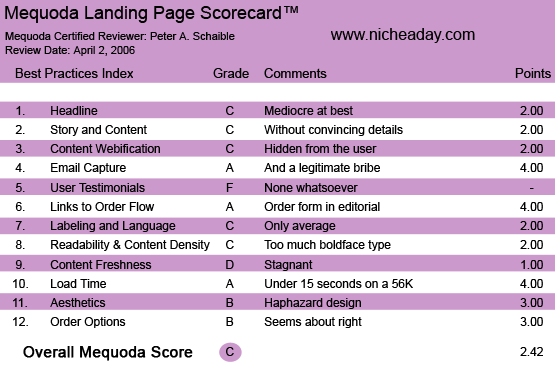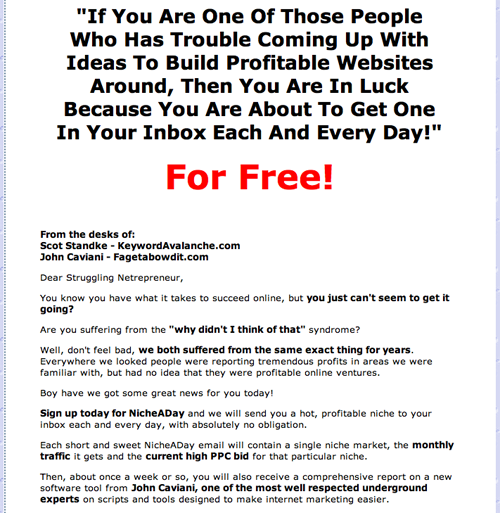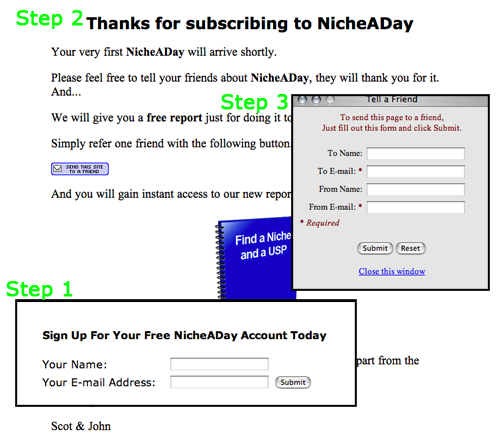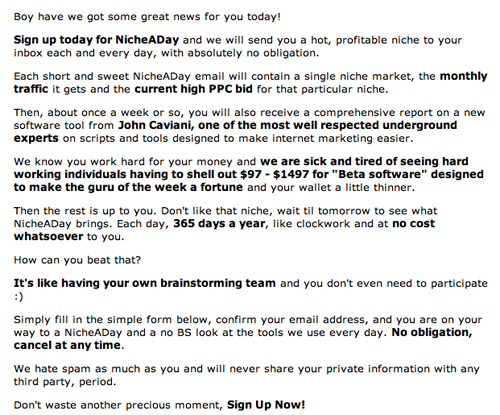The fundamental mistake made by many entrepreneurs is the classic chicken-and-egg scenario in which the inventor first creates a new product and then seeks a market for it.
Experienced product developers do the opposite. They anticipate the changes in society. They assess the evolving problems, requirements and desires of consumers, and look for opportunities that have not yet been addressed by the market. Then they forecast demand and create new products that fill the gap.
With the development and popularity of the World Wide Web, enterprising business people anticipated a need for tools and instructional materials and responded by creating a plethora of information products, including software, books and videos. Even experienced publishers who were unsure of exactly how to respond to the new medium enabled by Internet technology began developing new information products around previously unfamiliar topics.
Adding fuel to this dream of successful entrepreneurship via online publishing is the emergence of Google AdSense™. If the publisher creates good editorial content, and attains high search engine rankings, she can subsidize her website by selling advertising. With Google AdSense, another new business model was born—publishing free-access, content-laden websites, supported solely by pay-per-click advertising. And with that, the search for the right niche topics took on even more importance for online publishers and wannabes. Here again, the desire of entrepreneurs to find lucrative niche topics about which to write—and publish Google AdSense-laden websites—was eventually addressed by other entrepreneurs who recognized and addressed the opportunity-seekers market with products sold on their own websites.
One such site is NicheADay.com, a production of Scot Standke (KeywordAvalanche.com) and John Caviani (Fagetabowdit.com), a couple of entrepreneurs who are familiar with theopportunity-seekers market.
- The headline is fairly clear (but not so easy to read) and establishes the need to buy the product or service. But this is not the work of a journeyman copywriter.
- The sales letter doesn’t tell much of a story. I don’t find it to be compelling.
- This landing page uses just 400 words of copy to ask for your name and email address and promise a daily niche topic idea in exchange.
- User testimonials that feature actual results and benefits would add to this sales letter’s credibility. Alas, this landing page has none.
- Once you’re signed up, the daily emails from NicheADay.com arrive regularly and contain the information that was promised.

NicheADay.com’s Landing Page Scorecard
Introduction
The fundamental mistake made by many entrepreneurs is a classic chicken-and-egg scenario in which the inventor first creates a new product and then seeks a market for it.
Experienced product developers do the opposite. They anticipate the changes in society. They assess the evolving problems, requirements and desires of consumers, and look for opportunities that have not yet been addressed by the market. Then they forecast demand and create new products that fill the gap.
[text_ad]
With the development and popularity of the World Wide Web, enterprising business people anticipated a need for tools and instructional materials and responded by creating a plethora of information products, including software, books and videos. Even experienced publishers who were unsure of exactly how to respond to the new medium enabled by Internet technology began developing new information products around previously unfamiliar topics.
After all, the print publishing industry had experience in matching up the research and editorial skills of writers with the advertising sales and print production experience of publishers and creating information products for niche markets. So, the move to online publishing meant learning a new medium, but not entirely reinventing the wheel. Or did it?
Any paradigm shift in technology levels the playing field for everyone. With the advent of online publishing, experienced print publishers were thrust into a new business. Their previous skills included producing or buying the rights to editorial content, designing and manufacturing books magazines and newsletters, marketing these products and delivering them in physical form to retail outlets (or directly to customers).
Now, with the advent of the World Wide Web, information products could exist solely in an electronic format and be delivered directly to the consumer’s home or office over telephone wires.
The cost of entry into this marketplace was negligible, so opportunities abounded everywhere—for large publishing companies and individual entrepreneurs alike. Just as a few years earlier desktop publishing software and the personal computer had enabled nearly anyone to become a newsletter publisher, the Internet enabled nearly anyone to become an online publisher. And so the new Internet marketplace spawned numerous software products, self-instructional courses, books, online newsletters and membership websites devoted to specialized topics.
Once again, individual entrepreneurs jumped into the fray with every conceivable information product. Many were spawned by the unique subject matter expertise of the entrepreneur himself. For instance, a model train expert might develop an online newsletter for a small, but hungry, niche comprised of double 0 gauge railway modelers who collect trains using that track size. That’s a narrow gauge and an even narrower niche.
Meanwhile, other entrepreneurs—experienced print publishers—first assessed the size of niche markets, and then decided whether there was sufficient demand for a specialized online publication aimed at a particular market segment.
And finally, a third entrepreneur type emerged who first fell in love with the business model of publishing a membership website or online newsletter and then began looking for an appropriate niche market. These were members of a market segment known as opportunity seekers, primarily comprised of individuals who dream of a change in lifestyle that enables them to be self-employed, work at home and make a good living online.
The dream of being a successful online publisher has been aggressively promoted by the entrepreneurs who developed the software packages and other tools that enable non-technical PC users to operate a subscription website or online newsletter. The Panglossian business plan for a lone entrepreneurial publisher can be intoxicating.
“If I publish an information product for the right niche,” he reasons, “I need only 5,000 subscribers at $200 annually to gross $1 million. And I can perform without help all the jobs functions—content creator, marketer and webmaster.”
That’s the dream. So, instead of beginning with lots of content from another medium, as experienced print publishers might, the would-be online publisher first looks for a niche to fill.
Adding fuel to this dream of successful entrepreneurship via online publishing is the emergence of Google AdSense™. If the publisher creates good editorial content, and attains high search engine rankings, she can subsidize her website by selling advertising.
Google AdSense™ automatically delivers text and image ads that are precisely targeted to the site’s content. If site visitors find these ads useful, and click the hypertext links for more information, each click earns revenue for the site publisher.
Using Google AdSense™, some online publishers with great niche content learned they could earn more in ad revenue—with minimal effort and no additional cost—than they could from subscription revenue.
With Google AdSense, another new business model was born—publishing free-access, content-laden websites, supported solely by pay-per-click advertising. And with that, the search for the right niche topics took on even more importance for online publishers and wannabes.
Here again, the desire of entrepreneurs to find lucrative niche topics about which to write—and publish Google AdSense-laden websites—was eventually addressed by other entrepreneurs who recognized and addressed the opportunity-seekers market with products sold on their own websites.
One such site is NicheADay.com, a production of Scot Standke (KeywordAvalanche.com) and John Caviani (Fagetabowdit.com), a couple of entrepreneurs who are familiar with the opportunity-seekers market.
1. Headline (Strategic Intent) – C
“If You Are One Of Those People Who Has Trouble Coming Up With Ideas To Build Profitable Websites Around, Then You Are In Luck Because You Are About To Get One In Your Inbox Each And Every Day! For Free!”
OK, so the headline is fairly clear (but not so easy to read) and establishes the need to buy the product or service. But this is not the work of a journeyman copywriter.
First, who wants to be addressed as “one of those people”? Not very personal or intimate, is it? Terrible choice of words!
Second, it talks down to me (“trouble coming up with ideas”) and then tells me “I’m in luck because… ” That’s patronizing and mediocre at best.
A smart headline would talk about the opportunity that niche websites represent for those in the know. It would include the promise of “insider” information on what niche topics are most in demand. It would sell the dream of being a successful online publisher.
This headline doesn’t even come close.
2. Story and Content – C
This website is what the Mequoda research team calls a Rapid Conversion Landing Page (RCLP). The RCLP is used to entice a user to enter into a low-risk (AKA, low-friction) transaction, often when there is no cost to the user.
The free offer here is a daily email that cites a single niche market, the monthly traffic it gets and the current high pay-per-click bid for the keywords associated with that particular niche.
The sales letter doesn’t tell much of a story. I don’t find it to be compelling.
The storytellers (Messrs. Standke and Caviani) are clearly identified, but they don’t relate anything much of their own online success in niche markets.
The story is a loosely-strung-together series of statements without much logic or cohesion. There is little here in the way of a conclusion that moves the user to buy. But then again, it’s a free offer, so perhaps the publishers don’t feel compelled to work very hard at creating a compelling sales letter. It looks lazy when it should be energetic.

3. Content Webification – C
There are no text or graphics on the landing that have been webified. No innovative use of multimedia or interactive technology. Just 400 words of copy that ask for your name and email address and promise a daily niche topic idea in exchange.
4. Email Capture – A
This landing page uses just 400 words of copy to ask for your name and email address and promise a daily niche topic idea in exchange. There is no free downloadable report offered here and no use of pop-unders.
But when you sign up, there is a free report offered. That’s not the optimal timing, but I really like the thank you page for a different reason.
After you sign up for the free email newsletter, not only do you get the standard confirmation and thank you, but the message contains a tell-a-friend javascript within it. That’s great timing. At the precise moment the user is affirming that she wants to receive the free email newsletter, she is urged to validate that decision by sharing the experience with a friend. The free report is an additional bribe. Smart idea!

5. User Testimonials – F
User testimonials that feature actual results and benefits would add to this sale letter’s credibility. Alas, this landing page has none.
6. Links to Order Flow – A
This landing page includes a well-designed order form embedded right in the closing of the editorial content. A confirmation email is sent to the user and a double opt-in protocol is used. Well done!
7. Labeling and Language – C
This sales letter uses fairly clear language, but it is not logically constructed. There is a half-hearted attempt to create excitement and urgency, but it falls flat.
8. Readability & Content Density – C
Nearly half of the words in the sales letter are displayed in boldface type. That’s not pleasant to read and not very search engine savvy, either.

9. Content Freshness & Urgency – D
The content and references are stagnant. There is no date stamp, no reply-by date and no urgent call-to-action other than “Don’t waste another precious moment.” It’s one thing to write that; it’s another to state a reason why the user should act immediately.
Whenever possible, give the user a reason why to take action. Is the offer about to be withdrawn? Is a price hike imminent? Is the user losing money by not acting promptly?
10. Load Time – A
– Under 15 seconds
Download time for NicheADay.com was 3.06 seconds at 56 K as measured by the Webpage Analyzer.
11. Aesthetics – B
Make your website graphic design a priority and pick the colors with care. This site uses a poor choice of wallpaper for the background, which is inconsistent, with a strange looking border around only part of the text message.
I’ve never been a fan of using red for a type color, even for the words “For Free.” Red is the international color for danger. Use it very cautiously. When in doubt, don’t.
The graphic design of your site should be comforting and trustworthy for the target user, and consistent with his mental model. This one looks thrown together without much concern for the outcome.
12. Order Options – B
Inasmuch as the order form appears embedded in the editorial, and the offer is followed up by a confirmation thank you page and a double opt-in email, the bases are adequately covered.
Conclusion
Once you’re signed up, the daily emails from NicheADay.com arrive regularly and contain the information that was promised. According to the NicheADay.com email I received on March 31, 2006, the keywords digital photography were getting 52,293 monthly searches on Overture and had a high pay-per-click bid price of $5.
Why, it’s enough to really get your greed glands working, isn’t it? Now if I only knew something about digital photography and could create a website, by golly, I could make some serious Google AdSense™ money.
Two (anticipated) upsells from Scot Standke followed shortly after I signed up for the NicheADay email. The first is for a set of videos on how to enjoy Internet marketing success ($37). The second is for a $57 monthly membership website devoted to building niche portals around the Google AdSense program.
It would seem that the opportunity-seekers market is inexhaustible and insatiable, with an endless number of product developers addressing that niche.


